Campus Tour

War Memorial Tour of Columbia
 To print or enlarge the campus map, right click on the image and select "Open image in new tab."
To print or enlarge the campus map, right click on the image and select "Open image in new tab."
- Flagpole
- Earl Hall: Air Service School Commemorative Plaque
- Mathematics Hall
- West Wall: Battle of Harlem Heights Commemorative Plaque
- Dodge Fitness Center Plaque
- Pupin Hall
- St. Paul's Chapel: Nakashima Peace Altar
- Amsterdam Avenue: War of 1812 Commemorative Plaque
- Hamilton Hall: Mayor John Purroy Mitchel Commemorative Plaque
- John Jay Hall Commemorative Mantlepiece for Slain World War I Columbians
- Butler Hall Midshipmen's School Commemorative Plaque
- Butler Library: War Memorial Plaque
1. Flagpole
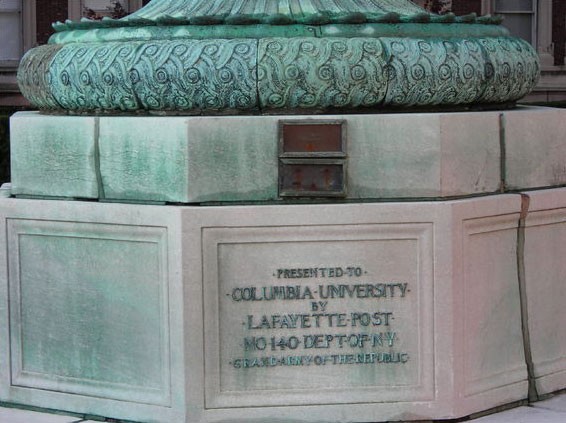
Walking away from Butler toward the center of campus, cross College Walk and go up the steps toward Low Library to the upper campus level. Then follow the sidewalk to the left, toward the flagpole.
Two flags were presented to Columbia on May 20, 1896, the day on which two of the cornerstones were laid for the original campus buildings. The flags were presented by members of the Grand Army of the Republic Post No. 140, Lafayette Post. The Grand Army of the Republic (G.A.R.), the first national veterans organization in the United States, was a fraternal organization for men who had served in the Union Army during the Civil War. Called to the flag of “peace, justice and prosperity,” those gathered on that day were asked to “love, cherish and defend it,” the words that are written on the bronze tablet at the base of the flagpole.
2. Earl Hall: Air Service School Commemorative Plaque
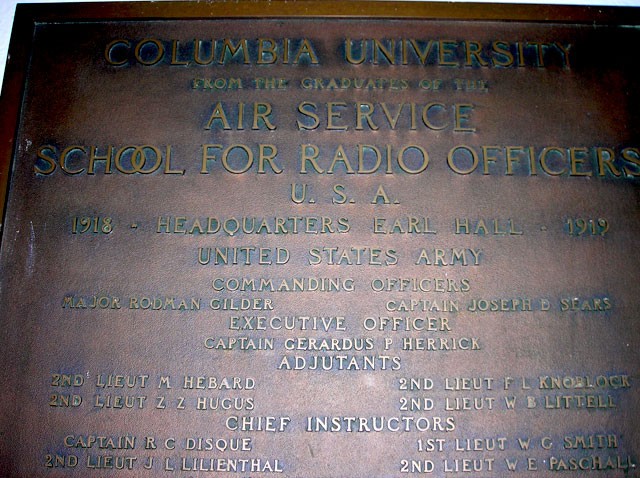
Walk to the left of the flagpole and proceed north a short distance on the sidewalk until you reach Earl Hall, the domed, red-brick building on your left. After entering the building, walk up to the first landing on the stairwell. Look up and you will see a plaque on the wall on the right-hand side.
The Earl Hall plaque reads, “From the Graduates of the Air Service School for Radio Officers U.S.A.1918 Headquarters Earl Hall—1919 United States Army Commanding Officers.” It names of individuals associated with the School, established by the U.S. Army Signal Corps to train its students to “care for the wireless used on airplanes and otherwise in connection with aviation.”
3. Mathematics Hall
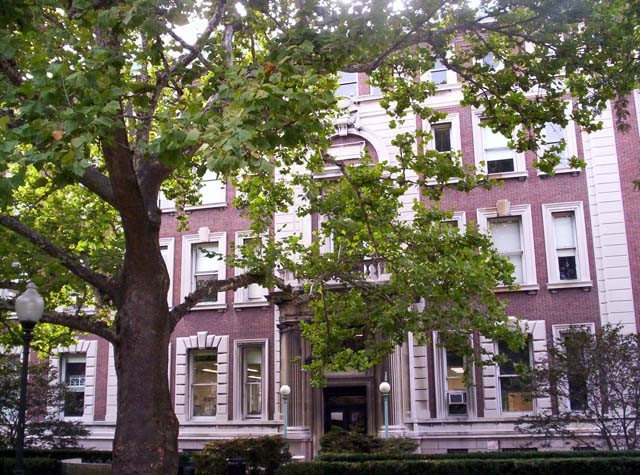
After descending the steps of Earl Hall, make two quick left turns on the sidewalk and look to your right at the building bearing the inscription "Mathematics."
The area around Mathematics Hall is thought to have been part of the Continental Army’s lines at the Battle of Harlem Heights during the American Revolution. Though inconclusive, the battle revived American morale after defeats on Long Island and at Kip’s Bay.
4. West Wall: Battle of Harlem Heights Commemorative Plaque

Continue down the sidewalk and descend the steps to the Earl Hall Gate. Turn right and proceed up Broadway, keeping your eye on the face of the wall to your right. You will come to a plaque located between West 117th and West 118th Streets.
The Battle of Harlem Heights plaque was designed by James Edward Kelly, a sculptor known for his depiction of military events and scenes from American history. He designed the Soldiers and Sailors Monument on Riverside Drive, as well as other memorials across the country. The plaque, a gift of the Sons of the Revolution in New York State, was installed in 1897, the year that the Morningside Campus was inaugurated.
5. Dodge Fitness Center Plaque
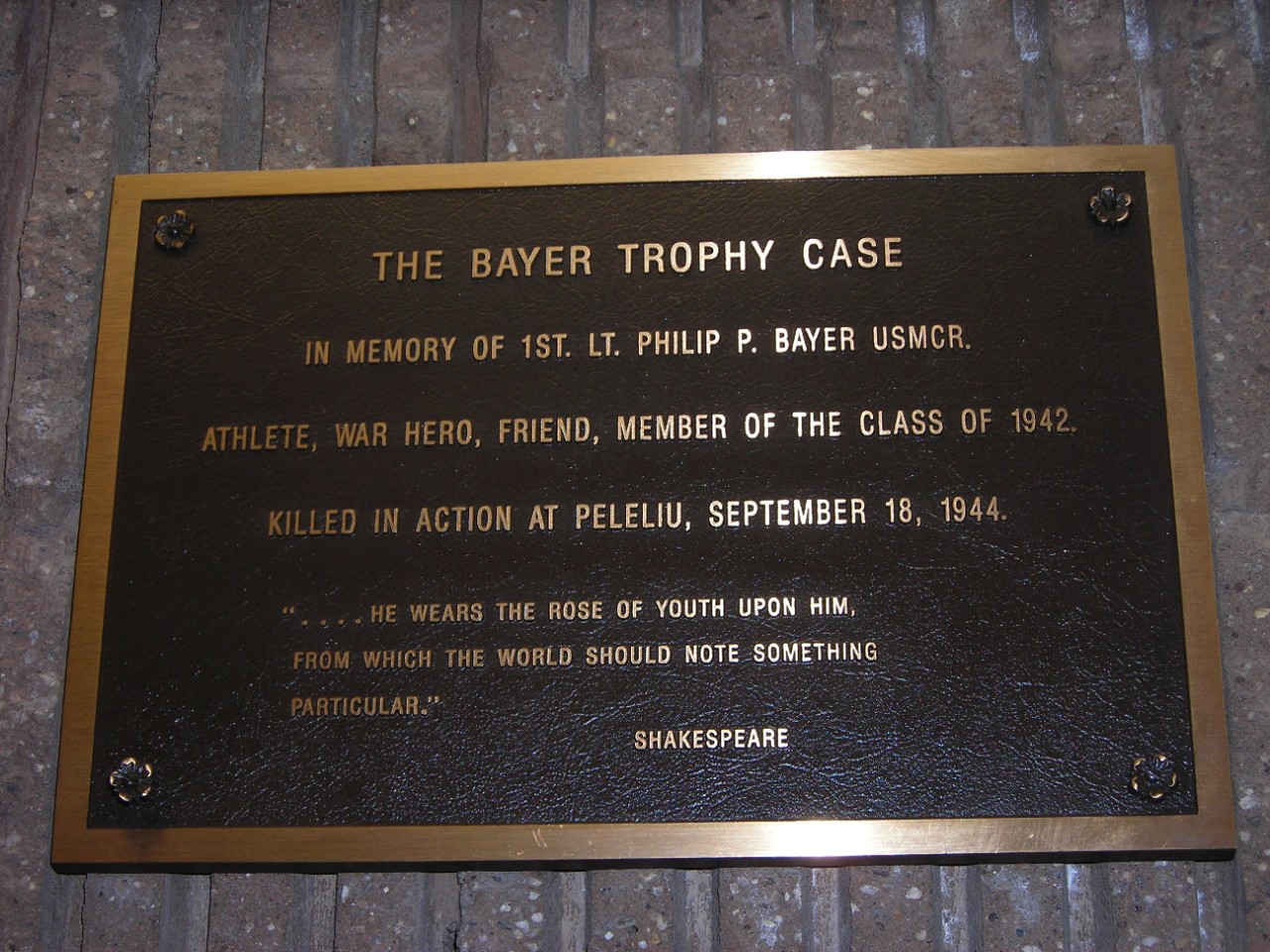
Enter Dodge Fitness Center and walk past the turnstile to the back of the room, then turn left. Look over the last glass case on the right hand wall. The plaque is installed directly over that case, known as the Bayer Trophy Case.
Plaque installed to commemorate 1st Lt.Philip P. Bayer, USMC, Class of 1942.
6. Pupin Hall
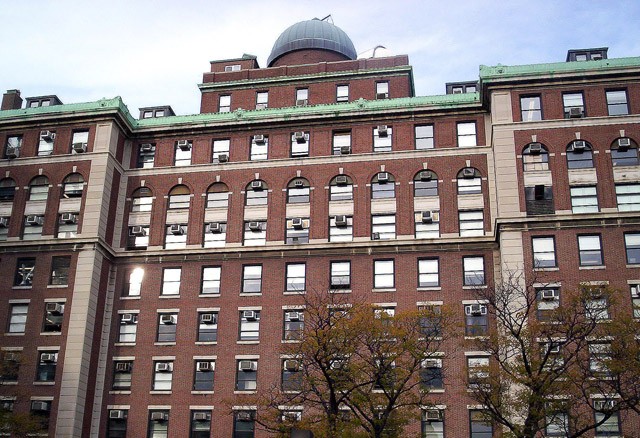
Retracing your steps, walk through the Earl Hall Gate, back up the steps and onto the campus. Turn left on the sidewalk before Low Library and proceed north toward West 120th Street until you are in front of Pupin Hall, the building with an observatory dome on its roof.
On January 22, 1939, John Dunning, a Columbia professor and later Dean of the now School of Engineering and Applied Science, and two student assistants split the uranium atom in the basement of Pupin Hall. The success of this experiment led to the Manhattan Project and eventually to the development of the atomic bomb. George Pegram, chair of the Physics Department, was also involved; he and Dunning collaborated with Columbia professor Enrico Fermi. Space was limited, and the project was vulnerable to the threat of enemy invasion because of Columbia’s proximity to the Hudson River. The project was relocated to New Mexico in 1942, but Columbia scientists continued to work on it until its completion in 1945. Pupin Hall is also the site where the maser (precursor to the laser) was invented.
7. St. Paul's Chapel: Nakashima Peace Altar
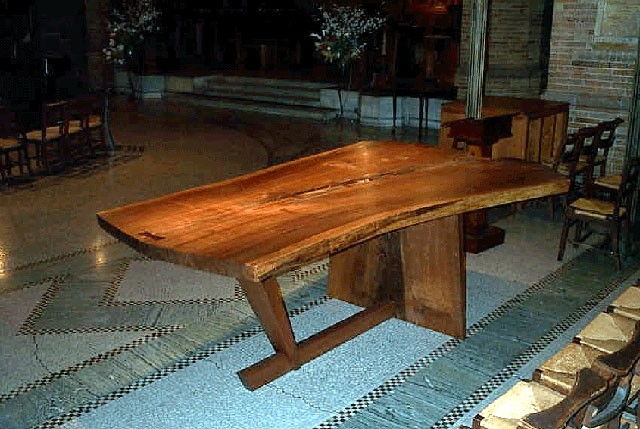
Retrace your steps until you come to the Wyeth lion, turn left and follow the sidewalk past the back of Low Library. Turn right and follow the sidewalk to St. Paul’s Chapel, on the left. Enter the chapel and walk forward along the right-hand wall until you reach the Peace Alter.
The peace altar, a gift of Professor and Mrs. William Theodore de Bary, commemorates those Columbians who have died in the service of their country. The altar was designed by George Nakashima, an MIT-trained Japanese American architect and sculptor who was interned during World War II along with many other Japanese Americans.
8. Amsterdam Avenue: War of 1812 Commemorative Plaque

Exit the chapel through the main entrance and proceed around the left side of the building. Walk down the stairs exiting the Chapel Gate and turn left onto the sidewalk along Amsterdam Avenue. Look up along the wall, where you will see a mounted plaque.
In August 1814, during the War of 1812, New Yorkers were warned to prepare to defend their city against a British attack. Columbia students and alumni traveled north from the campus, which at the time was located downtown near City Hall, to build fortifications across what would become the University's Morningside Campus. McGowan’s Pass and Fort Clinton, referred to on the plaque, were both located in what is today the northern end of Central Park, along West 110th Street. Fort Fish was near East 107th Street on the east side of Central Park.
9. Hamilton Hall: Mayor John Purroy Mitchel Commemorative Plaque

Walk south to West 116th Street and reenter campus through the Amsterdam Avenue gates. Walk west on College Walk to the end of Hamilton Hall and turn left. On the west wall of Hamilton Hall, as you descend the steps, you will see a bronze plaque.
A gift of the Class of 1899, the plaque commemorates John Purroy Mitchel, a Columbia alumnus who died in World War I after serving as the youngest mayor of New York from 1914 to 1917. Mitchel advocated universal military training, describing it as “the [only] truly democratic solution to the problem of preparedness on land.” After leaving office, he joined the U.S. Army and died at age thirty-eight in a training accident. The plaque was cast in 1919 by Jo Davidson, sometimes referred to as a “biographer in bronze” because of his many sculptures of world leaders and celebrated individuals.
10. John Jay Hall Commemorative Mantlepiece for Slain World War I Columbians
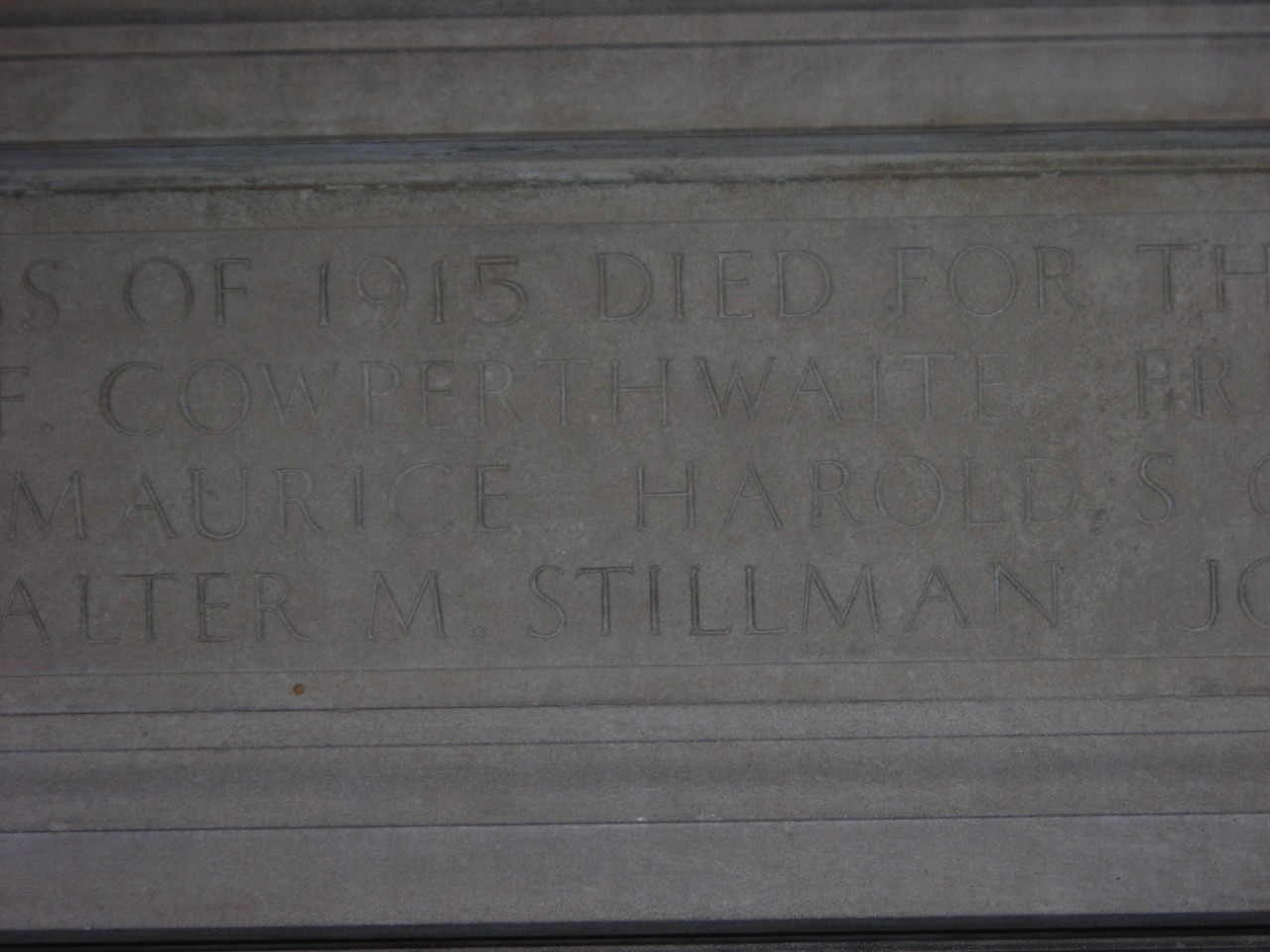
Walk south from Hamilton Hall and among the same cluster of buildings as Hamilton, you will see John Jay Hall directly in front of you. Enter John Jay and go down one flight to "J.J.'s," a student restaurant open most evenings after 6pm.
Mantle dedicated to a group of Columbians, Class of 1915 who died in World War I.
11. Butler Library Midshipmen's School Commemorative Plaque
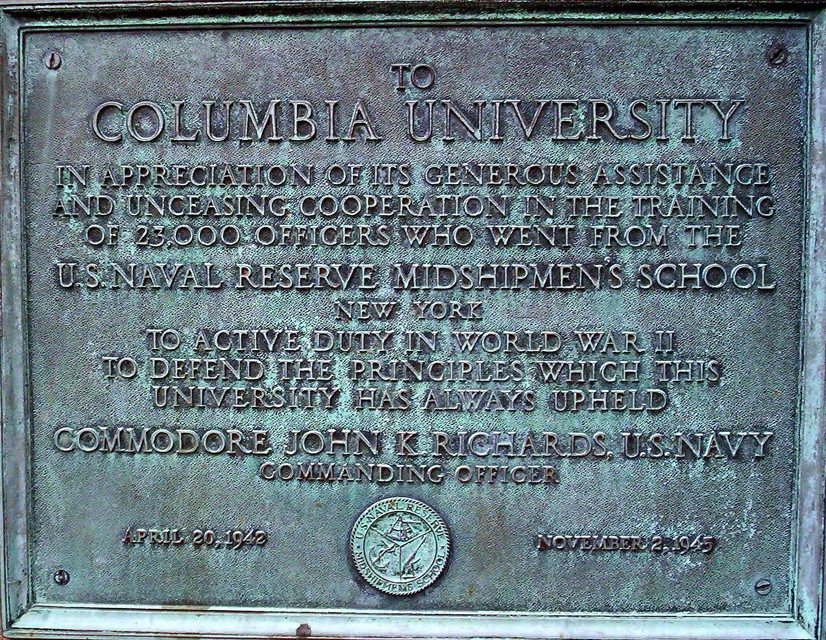
Walk northwest from John Jay Hall, toward the front of the large long white building on the south side of campus which is Butler Library.
On the east balustrade (left) of the short staircase approaching Butler Library, look below waist level and notice the plaque, a commemoration of the Midshipmen’s School, which operated on the Columbia campus during World War II. The Midshipmen’s School trained thousands of Naval officers for war service. Classes were held on the Columbia campus and in a ship docked at West 135th Street and the Hudson River. In all, it trained more than 20,000 officers.
12. Butler Library: War Memorial Plaque
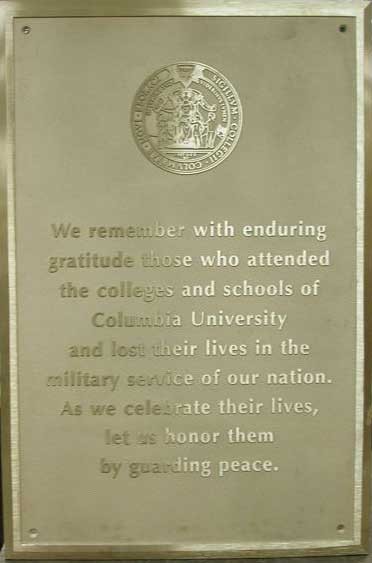
Turn right at the bottom of the steps and then left onto the sidewalk leading to the entrance of Butler Library. After entering the front door of the Library, look beyond the security desk. To the left of the staircase is a plaque commemorating the Columbia war dead. If you do not have a Columbia ID card and wish to look at the plaque more closely, enter the visitor's office immediately to left of the security desk.
The Butler Library War Memorial Plaque reads, “We remember with enduring gratitude those who attended the colleges and schools of Columbia University and lost their lives in the military service of our nation. As we celebrate their lives, let us honor them by guarding peace.” The plaque, which was unveiled in December 2008, honors the 460 known-at-the-time alumni who lost their lives in conflicts dating from the American Revolution.
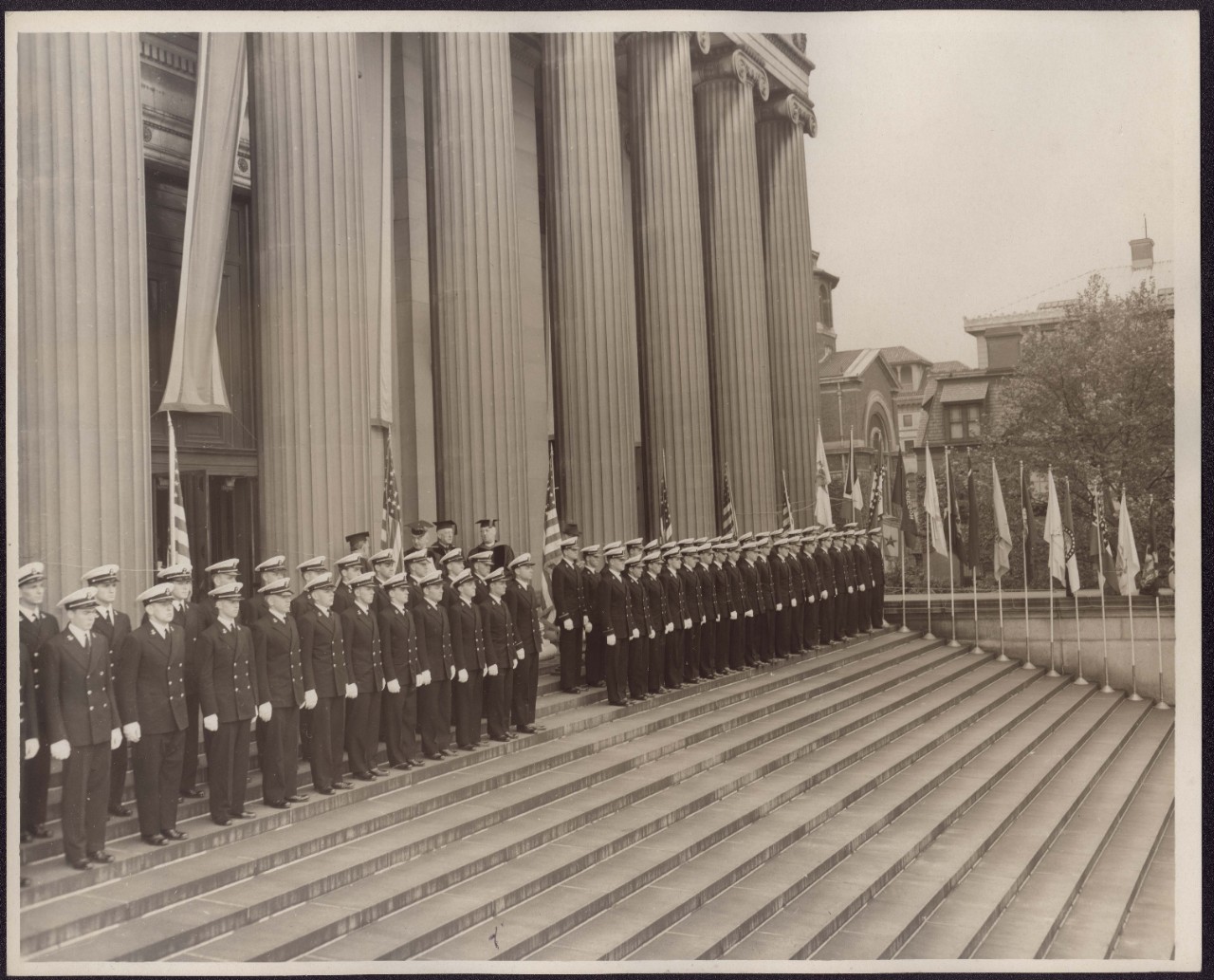 Navy midshipmen in front of Low Library surrounded by flags and banners
Navy midshipmen in front of Low Library surrounded by flags and banners